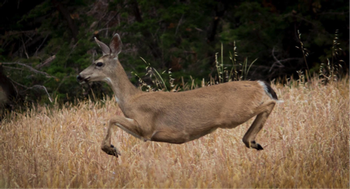Deer
-
AboutTwo most common are mule deer and black-tailed deer. Both eat shrubs, vines, fruit and nut trees, garden vegetables, grasses, and small flowering plants. Deer dislike some plants, especially when other more palatable plants are available.
 Photo: Karen Gideon
Photo: Karen Gideon -
Signs/Symptoms
Hoof prints two to three inches long, split in the middle, pointed at the front, and more rounded at the rear. Piles of small jelly bean-shaped droppings. Trampled plants and shredded or ragged foliage, buds, or terminals. Girdled trunks or branches broken by deer rubbing against them with their antlers.
-
Where
Deer are especially problematic in gardens next to woodlands.
-
When
Often feed late in the evening and very early in the morning. Where deer have become accustomed to people, they may be active throughout the day. When food is scarce, especially in fall, deer will eat most plants, including deer-resistant species.
-
Prevent
Grow plants deer tend to avoid. [4.3.1]
Exclude deer with fencing seven to eight feet high, if possible. Fence should be sturdy and fitted to the ground so deer can't crawl under it. Use wire or plastic plant protectors to shield individual plants. Chemical repellents may work in some, but not all situations. These include foul tastes or odors. It must be reapplied frequently. Many aren’t allowed on food crops or can damage some plants; read product label.
-
ManageN / A
-
More Information

